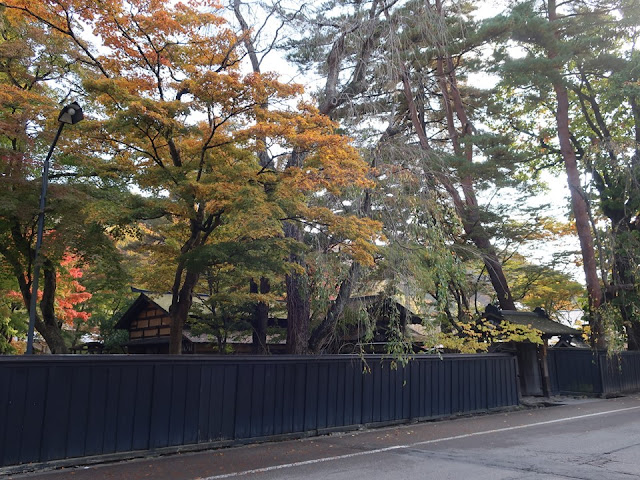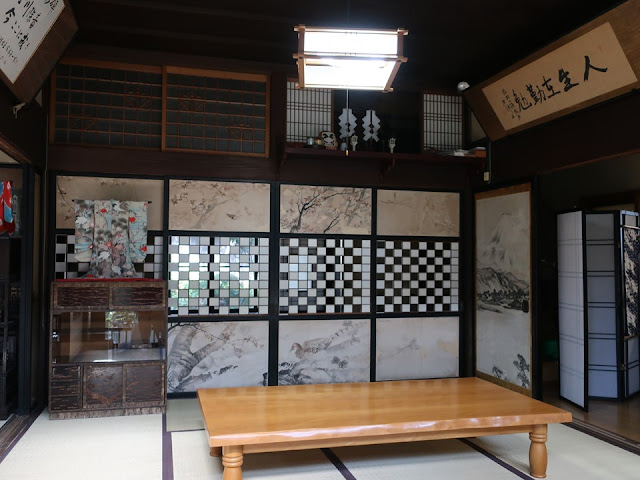Satake clan who ruled Akita in the Edo period (1603~1868) built the town. Satake introduced culture from Kyoto which was the capital at that time, because they had noble relatives there. It is one of the most major tourist
spots in Touhoku region; it is famous for its old samurai
houses.
角館は江戸時代に常陸から国替えになった佐竹氏の一門が作った町です。佐竹氏は京都の公家と親戚関係にあり、京文化がたくさん入ってきました。今は、武家屋敷が美しい東北きっての観光地です。
現役の商家にある展示室を訪ねました。
Samurai’s residential district、武家屋敷
Those were built along the wide road. The autumn leaves welcomed us.
道が広いです。角館と言えば、桜の川堤が有名ですが、紅葉の季節も観光客が多いです。
This is an ordinary residence on the street. It’s classy.
普通のお宅も素敵ですね。
Tomachi museum “Tatetsu”、外町史料館「たてつ」
“To-machi” means “To” for the outside and “machi” for the town. Merchants’ residential area is called “Tomachi”, on the other hand, samurais’ one is called “Uchi(inside)-machi(town)”. The museum is in the souvenir shop of wooden crafts, which is named “Kakunodate Kabazaiku Center”. It exhibits the valuables of Taguchi family who are members of Satake clan.
武家屋敷を内町というのに対し、こちらの商家の町は外町(とまち)と呼びます。史料館は、角館桜皮細工センターの中にあり、田口家で使用されていた品々が展示されています。
The entrance is at the far side of the shop.
史料館はお店の奥から入ります。
We walk the hallway beside the living room which has cool sliding doors called “shouji”.
居室の横を通って、奥に進みます。障子が素敵です。
Miniature kimonos are displayed in front of the actual one. Those are made from used kimonos.
打ち掛けから作ったミニ着物も展示されています。
The fire-proof storage at the end of premises is diverted as an exhibition room.
奥にある蔵が展示室です。
Ceramics and lacquerware are displayed on the left side.
蔵の右側には、ずらりと陶器や盆が並びます。春慶塗、編んだ竹に幾重にも漆を塗った藍胎漆器などがあります。
The photo above is a Shunkei lacquerware tray probably.
春慶塗だったと思うのですが、このお盆、いいです。
Taguchi family crest is set at the far side of the room. It is surrounded by kimono formal dresses and Nagamochi mobile chest for clothing and bedding.
田口家は佐竹氏の一族で、常陸国から移住してきました。家紋の暖簾、長持と着物が一番奥に展示されています。
Women in the Edo castle where in the shougun resided originated flat dolls. Thereafter, it spread to the ordinary people. It was nice that they had leeway to make something except for clothe.
押絵雛人形は、大奥女中の手遊びから庶民に広がっていったそうです。角館には日本画家の平福穂庵さんらがいて多くの押絵が作られました。身につけるもの以外を作るのに時間を使えると言うことは、豊かですねえ。
Everyday goods are elaborate. A rabbit is designed on the cigarette case. The owner’s Chinese zodiac sign would be a rabbit. (There are twelve zodiac sings. All of them are animals and make a circuit by 12 years.)
日用品も手が込んでいます。ウサギがデザインされたタバコケース、いいですねえ。兎年の人が作らせたのでしょう。
Lovely water boiler and kettles
湯沸かし器とやかん。愛着がわく品ですね。
The family would have brought lunch boxes above and have gone to the river bank to see the cherry blossoms. Good boxes make foods delicious.
弁当箱、これを持って川堤で花見。料理を美味しく見せる大切な道具です。
The family used Kutani-ware dishes for the dinner of the New Year’s Day. Those were made in Ishikawa pref. and were brought to Akita pref. by Kitamae sea liner.
お正月は、北前船で運んできた加賀の九谷焼の皿でお祝いました。
The family run a kimono shop in around 1900. The fans above were the mid-summer gifts. They had good tastes.
明治大正期にお中元にしたうちわ。上品ですよね。当時は呉服店をしていました。
店と蔵を結ぶ屋内の通路から見える庭も、よくお手入れされていました。
Official website: http://www12.plala.or.jp/kabasen/index.html#project-section (in Japanese), accessed in July, 2021
Andou’s residence、安藤家(安藤醸造 本店)
Andou family is manufacturer and distributor of miso paste and soy sauce. There is a fire-proof storage house which has a tatami mat floor in the shop. We can go inside the luxurious storage.
安藤家は、味噌や醤油の製造販売元です。中を座敷にした蔵があり、見学できます。
We proceed between the shop and the living space. The storage is on the left.
店先から通り庭を進みますが、右側は今も生活に使われているスペース。左側に蔵があります。
The entrance of the storage is connected to the main house. It is convenient in the snow season.
こちらも、蔵の入口は、家とつながっています
The storage house has two rooms. The interior is so excellent.
二間の蔵ですが、内装が一級品。
A wedding ceremony is held here. 結婚式にも使われます。
The view of the living space; it is also luxurious.
座敷を奥から見るとこうです。豪勢ですね。
Official website: https://www.andojyozo.co.jp/ando (in Japanese), accessed in July, 2021
Nishinomiya’s merchant house、商家の西宮家
I bought colorful seaweed roll. カラフルな太巻きを買いました。
The bank of Hinokinai River、桧木内川の堤
Here is famous for sakura cherry blossoms.
ここの桜は有名です(左上はACから旅人さんの写真)
Visited in October, 2020
Previous post (Museum in the port town of Akita):
Tsuchizaki
Minato Port Area Historical Museum、秋田市土崎みなと歴史伝承館
Next post (Merchant
houses in the old town of Akita):
Masuda town in Akita and an ex hardware store “Ishihei”、秋田県増田と旧石平金物店


























Comments
Post a Comment